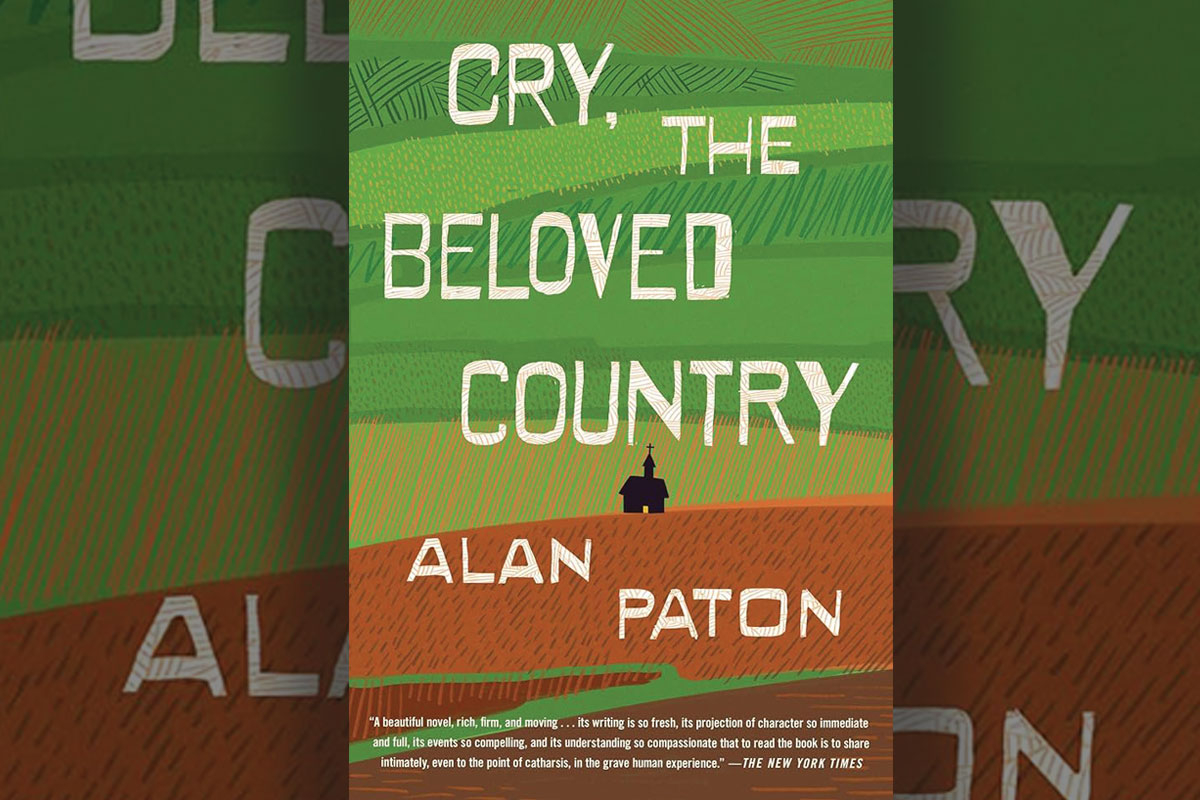Dig deep and ‘The Father’s Tale’ will reward
 Michael O’Brien’s The Father’s Tale (Ignatius Press, ISBN 978-0-89870-815-8) has more strikes against it than Babe Ruth on a bad afternoon.
Michael O’Brien’s The Father’s Tale (Ignatius Press, ISBN 978-0-89870-815-8) has more strikes against it than Babe Ruth on a bad afternoon.
Here is a doorstop of a novel, weighing in at nearly three pounds, more than one thousand pages long. There are redundancies galore; there are clunky passages; there are coincidences, particularly one involving a Russian military operation, that stretch belief to a breaking point. The characters engage in philosophical and theological debates that will annoy the car chase and bang-bang readers. Often the dialogue is didactic and polemical. The main character, Alex Graham, hails from Canada — O’Brien himself is a Maple Leaf man — a country which, should they think of it at all, many Americans would describe as safe, comfortable and boring. Finally, Alex Graham is a believing Catholic, and much of the novel explores that faith, an exploration that will offend — and in some cases, enlighten — those who take their ideas of Catholicism from priestly scandals, the Spanish Inquisition and The DaVinci Code.
Snake handlers riveting but cliché
 “... and these signs shall follow those who believe: in my name they will cast out demons, they will speak in new tongues; they will pick up snakes with their hands; and when they drink deadly poisons, it will not hurt them; they will place their hands on the sick and they will get well.”
“... and these signs shall follow those who believe: in my name they will cast out demons, they will speak in new tongues; they will pick up snakes with their hands; and when they drink deadly poisons, it will not hurt them; they will place their hands on the sick and they will get well.”
Clem Barfield, the sheriff of Madison County, has been doing his job for 25 years, yet as he ruefully notes, he is still considered an outsider.
Watch out! Bigfoot sighted in WNC
 I’d never read a horror-fiction genre book in my life. That is, until I found myself at an author’s event last month at Blue Ridge Books in Waynesville talking with Eric Brown about his recent book about Bigfoot (Sasquatch) set “here in the mountains over near Lake Fontana.” Being a sucker for tales of Bigfoot and Bigfoot mythology, I was immediately interested and asked for a copy of the book.
I’d never read a horror-fiction genre book in my life. That is, until I found myself at an author’s event last month at Blue Ridge Books in Waynesville talking with Eric Brown about his recent book about Bigfoot (Sasquatch) set “here in the mountains over near Lake Fontana.” Being a sucker for tales of Bigfoot and Bigfoot mythology, I was immediately interested and asked for a copy of the book.
Sequel picks up enticing tale
Although A Clash of Kings, the second in George R. R. Martin’s epic series, has a multitude of unforgettable characters, none is more fascinating than the grotesquely disfigured Sandor Clegane. Shortly before the final attack on King’s Landing, a great city that is under siege by four separate armies, Sandor has a conversation with Sansa Stark, a captive who owes her life to Sandor. Stung by Clegane’s mockery and contempt, Sansa says, “Does it give you joy to scare people?” Sandor’s reply could well serve a grim revelation and a daunting insight into medieval warfare and the dark heart of humanity:
“No, it gives me joy to kill people ... Killing is the sweetest thing there is ... You think it is all taking favors from ladies and looking fine in gold plate? Knights are for killing.” He laid his long sword against her neck, just under her ear. Sansa could feel the sharpness of the steel. “I killed my first man at twelve. I’ve lost count of how many that I have killed since then. High lords with old names, fat rich people dressed in velvet, knights puffed up like bladders with their honors, yes, and women and children too – they are all meat and I’m the butcher. Let them have their lands and their gods and their gold.” Sandor Clegane spat at her feet to show what he thought of that. “So long as I have this,” he said, lifting the sword from her throat.
This singular speech by a brutal, psychopathic killer summarizes the basic theme of A Clash of Kings. In spite of its mesmerizing splendor, George R. R. Martin’s fanciful world is often cruel and blood-splattered. This second book in the Songs of Ice and Fire series contains an excess of carnage. Thousands die in sea battles, drowned or burned by wildfire (a kind of medieval napalm). Countless lords and nobles are beheaded and thousands more fall before axes, swords and crossbows. Occasionally, the author pauses to note that the nameless dead – the “little folk” in ravaged villages and farms – they all die without the glamor of armor or heraldry. The rape and slaughter of multitudes are merely a by-product of war ... the small or common folk die simply because they were “in the way” and they die without purpose of meaning.
Yet, this is a compelling tale and the multitudes of readers seem committed to following this amazingly varied cast to the final (Eighth) book.
Here is a general summary of Book Two: Ned Stark’s tragic death at the end of Book I changed the lives of his family, many of whom fled for their lives. Others such as Sansa, Ned’s daughter, are trapped in King’s Landing, a prisoner (and bride-to-be) of the vicious boy-king, Joffery Lannister. The 12-year-old Arya Stark escapes and becomes a hapless servant to a half-dozen masters, but dreams of returning to Winterfell and her family. Ironically, Winterfell has been invaded and the fate of her brothers and sisters is unknown. Catelyn Stark, the widowed Queen of Ned Stark, joins her 15-year-old son, Robb who has named himself “King of the North” and vowed to avenge his father’s death. However, as he marches on King’s Landing, his father’s old enemies invade the Stark kingdom of Winterfell.
A Clash of Kings has an abundance of villains. Queen Cersei, although openly denounced as “incestuous and heartless,” manages to retain control of King’s Landing while plotting to rescue her lover/brother, Jaime Lannister, currently imprisoned by Catelyn Stark. A host of self-serving court officials murder, maim and betray at will. There is an offensive eunuch called “the whisperer” for his talent in relaying dangerous gossip and a finance officer named Littlefinger who has an almost supernatural ability to assassinate and betray with impunity. Invariably, his intrigue leads to his promotion to a higher office.
The most maligned character in A Clash of Kings is Tyrion Lannister, the ugly dwarf who has been nick-named “The Imp.” Despised by everyone including his father and sister, Tyrion survives by his wits and frequently finds himself cast into hazardous situations ranging from riding with a murderous band of thieves to serving as the King’s Hand (the most powerful position in King’s Landing). However, by the end of Book 2, the Imp’s hopes are dashed again. An assassination attempt and a battle wound has rendered him disfigured and helpless and he has been imprisoned by his own family. What next?
The most mysterious figure in A Clash of Kings is Daenerys Targaryen, the Mother of Dragons. The great battles raging in Westros are far removed from Daenerys’ “mission,” yet she believes that she is fated to reclaim her lost kingdom ... lost thousands of years ago, which is the Seven Kingdoms.
In an ancient time when dragons still ruled the skies, the Targaryen family ruled all of the known world. The heart of the Targaryen kingdom was the country recently ruled by Robert Baratheon and Ned Stark. Now, this “golden child” with a small band of devout followers is moving toward the coast of the Narrow Sea. Daenerys has a blind faith in the future. She will acquire ships and twenty thousand armed men, and they will accompany her to reclaim her lost kingdom. She will destroy “The Usurpers” and restore The House of Dragons. When Daenerys talks, people listen because she has something that attracts attention. She has three dragons. They are small, but they are growing larger every day.
Fledgling dragons are not the only bizarre creatures in A Clash of Kings. The world of the supernatural is growing stronger. A sorceress called “The Red Woman” appears in the court of Stannis Baratheon announcing a new religion – one that will sweep away all the gods, old and new. When Stannis accepts the Red Woman’s guidance and replaces his standards and flags with a new image: a heart within a radiant sun – a new destructive force is unleashed – a force that Stannis uses to destroy his enemies, including his own brother.
Finally, there is Jon Snow, the bastard son of Ned Stark, who has abandoned Winterfell and traveled north to join the Black Brothers: an army of dedicated warriors who keep watch on the Wall – a 600-foot high boundary that separates the land of mankind from the sinister forces of “the Others” which, in fulfillment of ancient prophecy, is beginning to move. With the coming of the Others, Jon and his comrades will fight what may be the “last battle.” Much of A Clash of Kings is filled with a sense of fatalism ... Winter is coming, a hundred-year-long winter that will change the world forever and render the dreams of the Starks, the Lannisters and even the Mother of Dragons meaningless.
Although this reviewer is tempted to continue reviewing Song of Ice and Fire through all eight books, he will not do so. It is time to return to more conventional literature ... works like Wiley Cash’s A Land More Kind Than Home. Stay tuned.
Finding the right word
In his Foreword to Robert Hartwell Fiske’s The Best Words (ISBN 978-193333882-8, $14.94), Richard Lederer reminds us of Mark Twain’s much-quoted declaration: “The difference between the almost right word and the right word is really a large matter – ’tis the difference between the lightning bug and the lightning.”
We live in an ocean of words. In addition to our everyday human speech, we listen to the radio, watch television, read books, play with Facebook, write emails and letters. Advertisements both heard and read are ubiquitous. Most of us throw out words with the casual disregard of a man emptying his pockets of loose change.
Yet our diction – our choice of words – often matters more than we realize. The right word can strengthen a friendship, console the sorrowful, inspire the discouraged, give pause to the smug and the self-satisfied. Some of Twain‘s “lightning“ words have even moved the hearts of millions and changed the course of our history: “life, liberty, and the pursuit of happiness,” “We have nothing to fear but fear itself,” “I have a dream,” “an evil empire.” The wrong word can break a business deal, a love affair, a marriage. Who has not regretted a word carelessly spoken, a reckless phrase emailed to an acquaintance, a heedless comment whose painful consequences come back to haunt us?
Our words matter.
Which brings us back to The Best Words. Robert Fiske has spent a good part of his life reminding all who would listen to him of the importance of writing and words. He is the author of several books, including The Dictionary of Disagreeable English and The Dimwit’s Dictionary, and the editor of the Vocabula Review, an online journal devoted to fine writing and the usage and peculiarities of the English language. He is a man who loves the play and scope of language.
In this most recent book Fiske collects more than 200 of what another reviewer calls “superlative words.” Chosen both from lists of favorite words sent in by Vocabula readers and by Fiske himself, these words truly are superlative because they are infrequently used yet eminently suitable for conversation and writing. Unlike some collections which offer sesquipedalian entertainment for its own sake – Peter Bowler’s wit in The Superior Person’s Book of Words series leaves readers laughing, but few of us will use words like mammiferous (having breasts) or lilaceous (having to do with slugs) – Fiske and his Vocabula crew have here collected a kit of serviceable tools. Employing his book, we can replace the well-worn enthusiasm with ebullient, sluggish with phlegmatic, ordinary with quotidian. Even the more exotic words found in these pages – hypergelast (one who laughs excessively), quincunx (an arrangement of five objects), coprolalia (the uncontrolled or obsessive use of obscene language) to name but three – seem selected because no other word will do in their place.
Some of Fiske’s entries may also serve as a first-line of defense against suspicion or intrusion. For instance, most of us recognize a misogynist as one who hates women, but it is splendid to learn its opposite, philogynist. This is a most useful word for a man at the beach in the company of a significant other. When she asks, “Must you look at every woman in a bikini?” he has only to reply, “It’s my phylogeny acting up again, dear. I’m not sure there’s a cure.”
The Best Words follows a simple design which benefits all readers. In newspaper-width columns, the reader comes first to the word, then a phonetic guide to its pronunciation, a definition or two, and examples of its usage by noted authors. Included in the back are six quizzes. This is a splendid book for students, particularly those soon to take an SAT, teachers, writers, and all lovers of the English language.
•••
Many books deserve a second look, but few will provide the entertainment and even the wisdom of Dodie Smith’s I Capture the Castle. Smith, who also wrote The One Hundred and One Dalmations, here drops us into the English countryside of the 1930s, where we enter the lives of the Mortmain family: Cassandra, the 17-year-old narrator and diarist, her beautiful older sister Rose, her step-mother, the exotic and loving Topaz, and her father, James Mortmain, a brilliant one-novel author suffering from more than a decade of writer’s block. All four scrape by in a falling-down castle leased to them.
Enter two young American men who have just inherited the castle and the nearby manor house. As the American become acquainted with English ways and with the Mortmains themselves, and as romance and love overtake all the characters, Cassandra records their adventures with high humor and intelligence. Cassandra is the perfect narrator here, innocent enough to still find amazement in the actions and words of others, literate enough to think of Shakespeare on a May afternoon, and with enough dry wit to give any reader laughter and pleasure. Through Cassandra Smith gives us a look into an England that may well be disappearing and into an English spirit that will, it should be hoped, endure forever.
If you know a reader among this year’s high school graduates, particularly a young woman, I Capture the Castle is one book whose wisdom and story should capture their attention.
Adding the stories of James Still to the Appalachian canon
For those who don’t know, James Still (1906-2001) is one of the most beloved and influential of all Appalachian writers. He left an enduring legacy of novels, stories, and poems during his nearly 70-year career. He is known formally and to many writers in the region as “the Dean of Appalachian Literature,” or more simply said “the Godfather of the Appalachian Literary Tradition,“
Originally born in Alabama, Still adopted eastern Kentucky as his home during the early years of the Great Depression. Life in Kentucky and the Cumberland Plateau became an integral theme in Still’s work, which evokes Appalachian culture, language, and landscape. Although best known for his novels and poetry, Still was also a prolific short story writer whose works often appeared in prestigious journals such as the Virginia Quarterly Review, Yale Review, and Prairie Schooner, as well as general interest magazines like the Atlantic and the Saturday Evening Post. When Still died in 2001 at age 94, he had secured a lasting reputation among readers of Appalachian literature based on a relatively small number of literary works.
The Hills Remember honors Still with the first comprehensive collection of his short fiction. The book includes stories from other Still collections such as River of Earth but also includes several lesser-known stories as well as 10 stories which have only recently been discovered and that have never-before been published. Ted Olson, who teaches in the Appalachian Studies and English programs at East Tennessee State University in Johnson City, Tenn., will be familiar to readers in Western North Carolina from his reviews, etc., as editor of the Poetry Page of Asheville’s Rapid River monthly magazine. Olson, in his landmark book, writes a comprehensive introduction concerning Still and his work and examines the author’s short fiction within the contexts of his body of work and within the canons of Appalachian and American literature. In his introduction, Olson favorably compares Still’s short fiction to that of other notable American writers as Poe, Hawthorne, Hemingway, Welty and Cheever. Presenting all of Still’s compelling and varied short stories in one volume, The Hills Remember is a testament to a master writer.
Still’s stories in The Hills Remember are distinctive in style and universal in theme. Still’s stories in this collection stand out as evocative and timeless yet remarkably accessible to the general reader. Simply said, these are “tales from the soul of Appalachia.” Not until recently with the writing of Charles Frazier, Wayne Caldwell and Ron Rash has the spirit of James Still and the mountain South been unleashed to a whole new generation of appreciative readers. And with Ted Olson’s new book of Still’s short stories, we can look for a whole new wave of popularity among a new and larger generation of Still fans — much as he was a household name in Kentucky during the 1960s.
If asked to choose amongst the 53 short stories in this collection, I would be hard-pressed to choose only one as an out-and-out favorite. However, the story “Hit Liked To a’ Kilt Me” stands out in my mind as one that is unique in this book as well in all of Appalachian literature. It is all about how this story is written in the dialect of what Appalachian poet (and friend of James Still) Jim Wayne Miller called “Southern Mountain Speech.” James Still is the only Southern writer, to my knowledge, who attempts to literally duplicate the southern mountain dialect. The title of this particular story being indicative of what the reader will find in his reading of this rich and at times raucous poetic language.
In the book’s title story “The Hills Remember,” a crowd gathers near the bank of Troublesome Creek to watch the villain of their Kentucky hill-town lie back in his own blood after being accidentally shot in the back. In its telling this story thrusts forward the universal themes of good and evil, right and wrong, and fate and chance. On the other end of the spectrum, in the story “Mrs. Razor,” Still gives us a whimsical story about six-year-old Elvy and her fantasy life as a wife and mother. “Mrs. Razor” gives us a glimpse into a child’s world of pretend and offers a heartwarming look at the relationship between father and child. In “Horse Doctor,” a young boy accompanies his father (Still’s father was a horse doctor with no official training) on a visit to a sick mare at a neighbor’s farm. Through stark prose and subtle imagery, the story reveals the naivety of the young narrator and explores the intricate relationship between Appalachian neighbors and families.
In one of Still’s most loved stories, “The Nest,” a young Nezzie Hargis becomes lost during a snow storm. In a seemingly unfamiliar terrain of isolation, in actuality Nezzie is never far from home. As she painfully struggles to find her way in the blinding storm, we see Nezzie mature from childhood innocence to adulthood. And in the story “Brother of Methuselum,” Still focuses on his character Uncle Mize, who by a strange twist of fate begins to grow young again at the age of 103 — his hair and teeth return, he props his walking stick in a corner, and he tosses his glasses away. “Brother Methuselum” explores the theme of immortality while offering us a story of Appalachian mysticism.
In a book that is endorsed on the University Press of Kentucky’s handsome cover by Appalachian luminaries Ron Rash, Loyal Jones, Gurney Norman, Chris Offutt and Jeff Daniel Marion, this is a must read for anyone who is “from here” or that has embraced the Appalachian mountain region as their own. We will learn more about ourselves than we knew and will be the better for having done so. The Hills Remember rests, as we speak, on my bedside table. It will remain there until I have read it from cover to cover — one story, each night, at a time. There is no better way to read a book of short stories. And this one’s a classic.
(Thomas Crowe is the author of the award-winning memoir Zoro’s Field: My Life in the Appalachian Woods and lives in Tuckasegee. He can be reached at This email address is being protected from spambots. You need JavaScript enabled to view it..)
The Hills Remember: The Complete Short Stories of James Still edited by Ted Olson. University Press of Kentucky, 2012. 406 pages.
George R.R. Martin’s world captures readers
Readers, be forewarned. If you willingly enter the fanciful world of George R. R. Martin’s Songs of Ice and Fire: A Game of Thrones, you may find yourself “enchanted” like some hapless knight in Arthurian legend. In other words, you will spend a significant part of your life, wandering enthralled through dark forests, frozen wastes and burning deserts — all inhabited by extraordinary creatures, mad kings and a host of doomed and deeply flawed characters, all vying for your attention. Can you afford the investment of time?
Dropping into the continent of Westros with its unstable weather, exotic flora and fauna and the medieval splendor of a land wrecked by seven warring kingdoms resembles being transported to an alien planet. Indeed, that may be the case since it quickly becomes obvious that Westros is not our Earth. Strange flowers bloom in well-tended gardens; terrifying creatures called direwolves and shadow cats move in the dark forest; and a mythical races, called the white-walkers and the “Others,” live in the vast darkness beyond a 600-foot-high wall of ice to the north.
Yet, this strange land has familiar qualities. The peasants spend considerable time in taverns, drinking beer and consuming soups that contain commonplace vegetables like cabbage, okra, pumpkin and tomatoes. The nobility drink rare wines and feast on steak and venison much like the royal courts of France and England during medieval times. In effect, this exotic world blends the pageantry of a 15th century court; the sultry eroticism of Arabian Nights and the ancient, pre-Arthurian mythology of the Mabinogion with a marvelous wrapping of magic and fantasy — all woven into a unique, blood-stained tapestry. In other words, Songs of Ice and Fire is the folklore and ancient tales of Planet Earth “enhanced” by George R. R. Martin’s imagination.
Like the ancient tales of England and Scotland, Westros contains the ruins of an ancient civilization called the “Age of Heroes.” However, the broken columns and abandoned cities of Westros are thousands of years old and the old myths speak of fanciful creatures: children of the forest, the walking dead and dragons who blended their blood with that of ancient kings. In addition, ominous and prophetic tales talk of the coming of a hundred-year winter which will destroy most of the world. In the kingdom of Winterfell, an oft-repeated mantra is “Winter is Coming.” When animals and people begin to migrate south and half-mythical birds called “snow snipes” appear in growing numbers, the kingdoms of Westros begin to hoard supplies and watch the sky with anxiety.
This sense of impending doom serves as a backdrop for a half-dozen plots, each of which has the complexity of a Shakespearean tragedy. The governing House of Stark in Winterfell (a northern city) has strong traditional ties with the House of Baratheon located in the southern city, Kings Landing. In addition, Lord Eddard Stark, acquires the title, “The King’s Hand,” which empowers him to act on behalf of King Richard Baratheon. Since the King has a weakness for hunting, drinking and sleeping with whores, Eddard spends much of his time in King’s Landing conducting “affairs of state” and council meetings. During this period, Eddard learns that Queen Cersei (House Lannister) is involved in a secret plot to make the heirs to the throne her children, who are all products of an incestuous affair with her brother Jaime Lannister.
Gradually, Eddard learns that King Baratheon’s court is totally corrupt and the plotting and intrigue extends to all of the Seven Kingdoms — all of which have governing families that have their own agendas. Before Eddard can alert King Richard of his wife’s plot, he finds himself imprisoned and branded a traitor to the throne. Among other ill-fated members of the Stark family are Eddard’s wife, Lady Catelyn (House Tully) and the entire family.
In time, the intricate web of treachery and deceit brings ruin and/or imprisonment to most of the Starks: The two daughters, Sansa and Arya, are trapped in King’s Landing. (Sansa is betrowed to the vicious and unstable Prince Joffrey). Seven-year-old Brandon stumbles on the incestuous Queen and her brother and is thrown from a lofty bedroom window — a fall that leaves him paralyzed and suffering from amnesia.
When 14-year-old Robb learns that his father has been declared a traitor, he raises an army and with Lady Catelyn’s assistance marches on King’s Landing. Eddward’s illegitimate son, Jon Snow abandons Winterfell and joins the Black Brothers, an army of highly disciplined soldiers who are sworn to defend Winterfell against the forces of evil that live beyond the northern Wall. As the Starks struggle to survive in the cauldron of intrigue, other kingdoms begin to take actions that are designed to destroy or sustain Winterfell and King’s Landing. Each decisive action (assassinations, covert invasions, secret treaties) resemble a deadly chess game.
No review of A Game of Thrones would be complete without the mention of Tyrion Lannister, a dwarf who is called “The Imp,” and the exotic Princess Daenerys and her brother, Viserys, who claim to be descendants of the ancient House Targaryens called themselves “Blood of the Dragon.” Among the cast of characters, Tyrion is the ultimate outsider — a man who compensates for his physical deformities by his wit and a shrewd ability to understand the motives of others, especially his arrogant and treacherous brother, Jamie. However, Princess Daenerys harbors a secret desire for vengeance which involves “waking the dragons” and marching on kingdoms of Winterfell and King’s Landing ... her ancient enemies.
These complexities of plot may be this bloody saga’s most bewildering characteristic. Readers may find themselves re-reading chapters in order to keep track of kingdoms and blood feuds. However, George R. R. Martin’s powerful and beautifully crafted narrative holds our attention. While it may be difficult to summarize the tangled threads of intrigue which involve several hundred characters, this fantasy shimmers with memorable scenes and characters. For example, the presence of the dire-wolves, six pups raised by the Stark children, acquire an eerie presence as they pad silently behind their charges, guarding them against ever-present threat. The descriptions of feasts, jousts, warfare, and a good bit of sweaty sex is done with graphic detail. The painfully detailed descriptions of clothing and armor is especially noteworthy.
A Game of Thrones has a number of strong themes that focus on women in crisis; the presence of a religion thought to be destroyed, but which still exists in the natural world where “the old gods and the new” are dormant, but vitally alive.
A final comment on the HBO series based on Game of Thrones. It is magnificent. Perfectly cast and stunningly photographed, this series is undoubtedly the best program on current television. As for that oft-repeated concern, “Is it as good as the book?”.... Yes, it is. In fact, in some instances, it surpasses the book. And this is just the beginning! There are eight books to go.
(Gary Carden can be reached at This email address is being protected from spambots. You need JavaScript enabled to view it..)
A Game of Thrones, Book One by George R. R. Martin. Bantam Books, 1997. 726 pages.
Dusting off a few worthwhile volumes
Spring-cleaning remains a ritual in many households. We throw open windows, rid closets, shelves, and drawers of unwanted items — books, papers, video cassettes, sweaters that haven’t seen daylight in 10 years, Aunt Matilda’s time-blighted photographs of zinnias — wash everything from curtains to cars, and finally settle down with the perfume of ammonia and Windex gilding the air.
In my own case, spring-cleaning also includes clearing the left side of my desk of books awaiting review. Here a hillock of volumes, read with varying levels of enjoyment, have gathered dust these last few months, awaiting their turn in this column. Without further ado, I present to you three different books that may deserve your attention.
Jim Harrison’s The Great Leader (ISBN 978-0-8021-1970-4, $24) contains many of the trademarks of Harrison’s other novels: a style that pulls the reader through the story, a hero with many flaws balanced with good intentions, a concern with philosophy, religion, food, liquor, and sex. Detective Sanderson, Harrison’s hero, divorced, frequently drunk, recently retired from the Michigan state police, spends much of his retirement and the novel chasing down a creator of religious cults while at the same time reminiscing about his past. He follows this culprit, the Great Leader, from Michigan to Arizona and then to Nebraska, all the while recollecting his adolescence, his life with his wife, various sexual encounters, and his love of nature and the outdoors.
What Harrison does best here — and his other novels — is to write poetic paragraphs stuffed full of philosophy, poetic diction, and entertaining asides. A random examination of The Great Leader yields paragraphs like this one:
“He hit the radio off button when someone on NPR used the word turd iconic. He used to keep track of these obtuse Orwellian nuggets. A few years ago it was the relentless use of the word closure that raised his ire and then with Iraq the silly term embedded … Pundits reflected his idea that everyone in America gets to make themselves up whole cloth, and also the hideously mistaken idea that talking is thinking.”
Where The Great Leader, Sanderson, and Jim Harrison fall flat on their collective face is in their ideas of sex. Older men — and here I mean men over 55 — do indeed dream of the affections of women, especially younger women, but it is doubtful that younger women cast themselves as frivolously and as frequently at older men as women do at Sanderson. This retired detective has little to recommend him to the younger lovers; he is dull, stuck in the past, aged, lacking in looks and money. Yet women ranging from his teenage neighbor, Mona, to various waitresses all seem to take a shine to him. The novelist’s infatuation with this topic — younger women and their involvement with old guys like Sanderson — borders on the obsessive, so that even the most dilatory reader must wonder whether Harrison is sketching from life or indulging in his own maudlin fantasies.
•••
In Fannie’s Last Supper: Re-creating One Amazing Meal from Fanny Farmer’s 1896 Cookbook (ISBN 9781-4013-2322-6, $25.99), Chris Kimball, founder of Cook’s Illustrated and host of America’s Test Kitchens and Cook’s Country, sets out to make a gourmet meal using recipes from what was once America’s most popular cookbook. The problems with such a re-creation are multiple — finding the right ingredients, using the same equipment, deciding whom to invite to the meal — but Kimball’s greatest difficulty lies in the fact that the recipes from Farmer’s Boston Cooking-School Cook Book too frequently turn out to be second rate, poor cousins to their French counterparts of that age and cousins several times removed from our own culinary specialties. Several times, forced to choose between following Farmer’s mundane recipes or his own good instincts and superior knowledge of food, Kimball finds himself playing variations on Farmer’s work and criticizing her cooking skills.
Far more interesting than the recipes here is Kimball’s investigation into the food and manners of late nineteenth century Boston. From him we learn the intricacies of cooking on a wood stove, the growth of various farmer’s markets in Boston, and the life of a cook in a Victorian household. We discover that the Victorians, unlike modern epicures, disliked the odor of cooking foods and so built their kitchens at the rear of the house; that Boston by 1896 was a shopper’s paradise for cooks, “a vastly better and more convenient place … than Boston today;” that jellies and gelatin dishes played a far greater part in meals of the time than today. Kimball’s historical sense and mastery of details provide an engaging account of Boston social life and entertainment.
For anyone interested in either cooking or the social history of nineteenth century America, Fannie’s Last Supper is a feast in its own right.
•••
Though poetry has lost its shine in the age of twitter and tweet, verse remains the blood and heart of literature. Great verse retains the power to steel our nerves, to open our souls, to sing to us like Eliot’s mermaids. April was National Poetry Month, but it’s never too late to crack open that dusty Norton Anthology or to search out poems old and new on the internet.
On my desk is a copy of A Poem A Day, edited by Karen McCosker and Nicholas Albery. Most mornings I forget to read from it, but when I do remember to seek out that day’s poem, I am reminded once again of the vigor of the English language and the beauty of carefully selected words and forms. Many writers can walk, and some can run, but the great poets open their arms and invite us to dance.
(Jeff Minick is a writer and teacher who can be reached at This email address is being protected from spambots. You need JavaScript enabled to view it..)
‘Raylan’ is business as usual for Leonard
Like a growing number of FX addicts, I have become a devoted fan of “Justified” (Timothy Olyphant and Sylva’s own Nick Searcy) that airs each Tuesday night at 10 p.m. This fast-moving, smart-talking, funny and violent show represents the culmination (or harmonious convergence) of several remarkable talents: a short story entitled “Fire in the Hole” by Elmore Leonard (which became the basis for the FX series, “Justified”) and the marvelous nuanced acting of Oliphant, who stepped into the custom-made boots of U. S. Marshall Raylan Givens like he was born to play this part.
“Justified” is that rare thing, the merging of Elmore Leonard’s talent for writing dialogue that sizzles and pops like frying bacon, and Olyphant’s uncanny talent for becoming a Kentucky-bred Federal agent who has acquired a reputation for being a little too quick to provoke “violent confrontations.”
Raylan is that rare thing, a novel spawned by a successful television show that is based on an original short story by the same author. Of course, most readers know about this “crime/fiction” writer who has a legendary talent for writing screenplays: Consider this partial list: Valdez is Coming; Hombre; The Moonshine Wars; The Bounty Hunters; Gold Coast; Kill Shot. Leonard’s versatility is astonishing. Frequently, his dialogue is filled with double entendres and “inside jokes”.... like when a character in an episode of of “Justified” picks up the phone during a tension-filled moments, hangs up and turns to tell a crowd of well-armed listeners, “Valdez is Coming.”
Essentially, Elmore Leonard is so pleased with the success of “Justified,” he has decided to write a new novel based on the further adventures of U.S. Marshall Raylan Givens. Raylan vibrates with energy, humor and tension. Take for example the episode that begins with Raylan discovering Angel Arena, a major drug dealer, floating in a hotel bathtub filled with blood, water and ice. Angel’s kidney’s have been removed and someone has closed the incision with a stapler.
Angel survives and the following day, he receives a ransom note that offers to return his kidney’s for $100,000. Before long, Raylan is caught up in one of the most bizarre cases of his career and the personalities are memorable: Dickie and Coover Crowe, two pot-head brothers (and old acquaintances of Raylan’s) who act as “procurers” for an Afro-American nurse named Layla and her con-artist lover, Cuba (pronounced Coo-ba) Franks. Since Layla has “assisted” in hundreds of kidney transplants at Harlan County’s stylish medical center, she is admirably qualified to remove the kidneys of wealthy victims. Coba and Layla are well on their way to becoming millionaires when Raylan shows up and the plot becomes both complicated and kinky.
Then there is Delroy Lewis, a drug-dealing gambler who has developed a profitable business involving topless dancers. The girls are all addicts who have been trained to rob banks and deliver the stolen funds to Delroy. The money rolls in and when any of the dancers become incompetent, Delroy simply shoots them and leaves their bodies in a vacant lot. They are easy to replace.
Ah, but there is one problem. Delroy has a serious grudge against Raylan Givens and fantasizes about engaging in a western style shootout. Since Delroy has a penchant for cross-dressing, he decides to set a trap in a gambling saloon where he will be disguised as a “statuesque beauty with a platinum wig” with a Smith .357 in his purse. The resulting “gunfight” manages to be tense, terrifying and hilarious.
Raylan is packed with characters that are vitally alive and some of them have become regulars on “Justified.” There is Boyd Crowder, a reluctant employee at the M-T Mining Company which is in the process of destroying the quality of life in Harlan County. As “security officer” for the mining company, Boyd has discovered that his duties include intimidation, bribery and accessory to murder. Carol Conlan, a brutal coal mine executive who has turned into a “Justified” regular, finally gets her due in Harlan when she is shotgunned by a miner’s widow in the local nursing home.
Of course, there is a priceless episode involed in Carol’s demise, but that is possibly this novel’s singular flaw. It possesses an intricate and tangled narrative with events so intertwined, it is nearly impossible to unravel one tale without releasing a half-dozen others. In order to put Carol Conlan’s personality and death in proper perspective, it is necessary to tell the story of Otis Culpepper, the old miner who has become an “inconvenience” to the M-T Mining Company — a problem that Conlan solved by simply shooting the old man. In addition, there is the story of Pervis Crowe, a rugged, old survivalist who sells and/or controls every illegal activity in Harlan County. In addition, there are a dozen marvelous characters who make a brief appearance and then vanish through the nearest exit .... like Jackie Nevada, a college girl/professional gambler who impresses Raylan by winning a million dollars.
Finally, Raylan acquires a pardner in this novel and hopefully, he is going to be around for a long time. He is a former white supremacist with swastika tats named Bill Nichols. Somewhere in his experiments with violence, Bill “saw the light” and became an uncompromising agent for justice. Raylan and Bill look and act like a matched set, and hopefully he will return often, giving us some fantastic dialogue as these two U. S. Marshalls compare notes on topics like divorce, moonshine, young women and killing people.
Raylan by Elmore Leonard. HarperCollins, 2012. 263 pages.
The tales of two Joyces
In The Guys in the Gang and Other Stories (ISBN 978-1-4697-7768-9, $20.95), James T. Joyce and James T. Joyce — that doubling-up is not a misprint — have shared, perhaps inadvertently, the secrets to a fulfilling life. Like a fine symphony, which often consists of four parts, all of them intertwined in some way, bound together by tone and motif, The Guys in the Gang offers four important ingredients for leading a full and worthy life: faith, family, friends, and fun.
Both of these men (they are distinguished in the book by reference to the streets, Ada and Carpenter, where they grew up. James “Ada” Joyce lives in Waynesville.) came of age in Irish-Catholic Chicago in the heady years following World War II. This was the era when the Catholic Church held sway over its parishioners in ways that today seem as strange as fins on cars and rotary dial phones. The nuns directed the parochial schools, the priests commanded the churches, and the monsignors and bishops ruled over them all.
Joyce and Joyce both suffered the usual abuses of parochial school — Brother Sloan, the religion teacher, would “simply flail away at you slapping, punching, and kicking” — and grew up in families in which faith was as familiar as the daily paper. “Ada” Joyce, for example, writes that his father turned off the television every day of Lent and that his mother, a leader in the large parish church, frequently said the rosary on the two-hour drive to her family’s farm. (One of the Mysteries of the Rosary is “The Agony in the Garden,” which Joyce’s friends, who traveled with him on these excursions, later renamed “The Agony in the Car.”)
Family, too, played a role in shaping these two men. Both men came out of strong families. Both men honor this bond by speaking highly of their parents, wives, children, and various relatives.
It is, however, the portraits of their friends and their mutual adventures that distinguishes The Guys in the Gang from similar memoirs. Through high school and into the years immediately following, both men belonged to the same gang of friends, guys who partied hard, worked at all sorts of after-school jobs, and indulged in their spare time in all sorts of pranks, some of them silly, some of them truly dangerous. These accounts make up some of the most humorous portions of the book. At one point, 16-year-old Jim “Ada” Joyce is driving his Dad’s new Olds 88 when one of the gang asked how fast the car could go.
“I put the accelerator to the floor and our heads snapped back. We went past 100 like it wasn’t there; 110 was gone and the max, 120, provided no obstacle.
“The speedometer was a circle with a yellow needle pointing to speed. The needled continued around the circle until it hit zero, completing 360 degrees. Then it went “twang,” popped off the spindle and came to rest at the bottom of the glass. A thin, plastic coated wire now appeared behind the numbers. I immediately slowed down and said, ‘Oh, s**t!’”
There are some great stories about the “gang,” and “Ada” Joyce has the eye for details and irony that will bring a smile to the reader’s face.
Carpenter Joyce, who became a Chicago fireman, reports more somberly on the fate of the neighborhood. Both Joyces grew up in the civil rights era and racial unrest, and Carpenter Joyce tells of the demise of the Saint Sabina parish when integration came to the neighborhood. As in cities across the nation, African-Americans moved into some urban neighborhoods, and whites moved out. Here Joyce gives us a first-hand look at “white flight” and its influence on this particular Chicago parish.
In the second half of their memoir, the Joyce duo gives us a brief record of their adult lives. “Ada” Joyce, who has already recounted his Army and Vietnam experiences in Pucker Factor 10 and his work as a psychoanalyst in Use Eagles If Necessary, focuses here on this work as a businessman, while “Carpenter” Joyce briefly gives an account of his life-long work with the Chicago fire department. Once again their reminiscences provide a good deal of humor while at the same time shining a light on certain aspects of human nature. This last part of the book also contains a number of memorable farewells to friends who have died.
What marks the book overall is its sense of esprit and fun. These are two men who have, by most measures, lived what society considers successful lives. In addition to earning a good living, each man has also faced various ordeals and emerged with a sense of amusement intact. Both have a knack for seeing the humorous side of difficult situations, a sense of the absurd which doubtless helped carry them far in life. It is their sense of fun and their recognition of the ridiculous that has carried them through life and carries the reader through the memoir.
(Jeff Minick can be reached at This email address is being protected from spambots. You need JavaScript enabled to view it..)
The Guys in the Gang and Other Stories by James T. Joyce. iUniverse, 2012. 276 pages.






















